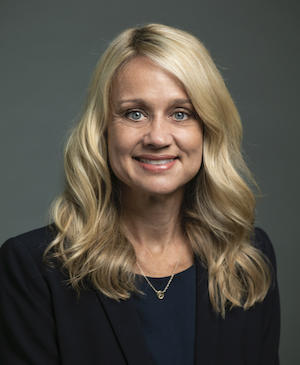Last August, George Mason University faculty and students participated in a series of virtual simulations of school shooter incidents as part of an effort to help the Department of Homeland Security (DHS) and MITRE Corp. determine best practices for school safety. As a result, DHS’s Cybersecurity and Infrastructure Agency recently released an after-action report recommending ways to protect and increase survival rates of students and staff in such situations.
Stephanie Dailey, assistant professor of counseling in the College of Education and Human Development and Kathryn Laskey, professor of systems engineering and operations research in the Volgenau School of Engineering, were the faculty leads on the project. The simulation experiment (SIMEX) was set in a virtual high school environment modeled after designs in current suburban schools supporting about 1,000 students. Mason faculty, undergraduate and graduate students, and outside educational professionals played the roles of teachers and students. Outside organizations provided school resource officers and administrative personnel.
During the two-week simulation, participants ran through scenarios in which there were different conditions, such as the absence or presence of a school resource officer or manually versus automatically locked classroom doors.
“Immersive simulations allow researchers to study the problem scientifically,” said Laskey. “It’s a way of putting people in as close as situation as possible to the real thing to study what works and what doesn’t.”
Laskey added that Mason researchers partnered with DHS and MITRE because they wanted to help “understand a problem that is of pressing importance in our society."
Participants were in the same area in MITRE’s laboratory in McLean, Virginia, to monitor them during the process. They followed COVID-safe procedures, said Dailey.
“They had to be in one area because we needed to be able to observe the operators for signs of psychological distress,” said Dailey. “Despite being a very difficult topic, Mason students wanted to participate to make a difference, to be a part of finding evidence-based solutions.”
The final report recommended that schools should consider having classroom doors that automatically lock when closed, and school resource officers (SROs) or equivalently trained security professionals may prevent fatalities during an active shooter event. However, the report also found that while a SRO’s presence improved the safety of students and teachers during an active shooter event, schools need to carefully consider ways to increase situational awareness for SROs and administrative personnel.
James Dear, MITRE project manager of the SIMEX program, said that Mason was critical to “the success of the School Security SIMEX by not only screening and training the research subjects, but also assisting in developing the data collection plan, analyzing the SIMEX data and contributing to the SIMEX Final Report conclusions and recommendations.”
“The Mason team served as an integral part of the School Security SIMEX,” said Lindsay Burton, a member of the Department of Homeland Security’s School Safety Task Force. “The participation and key insights from the student volunteer participants along with guidance and expertise provided by the faculty directly contributed to the successful conduct of the experiment.”


